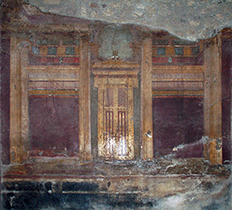 1>
1>Actorless stages?
The wall-paintings thought to represent actorless stages are collectively associated with the Second or Architectural Style. The majority of them contain no figurative references, the minority that do consist of unidentifiable figures, statuary or masks. In his 1936 essay Scaenographia A.G.M. Little identified both groups as, "...some twenty theatrical pieces in all...". The majority of which he concluded, "...belong to the tragic group...", which he defined as, "...a palatial propylaeum (which may be interpreted as that of a palace, or shrine, or public square) giving onto a peristyle court". He then went on to further divide the 'tragic' group into three 'types'. "In type I the peristyle is closed by doors; in type II a vista discloses a tholos shrine in the central opening; in type III the far side of the empty court is visible." (Little 1936 : 411) (figs.1-3). Before going on to examine his hypothesis we first need to clarify his reference to a propylaeum, which is normally definition as a ceremonial gate or portico leading to a temple or shrine. Little's addition of the words 'palatial' and 'palace' may well be an attempt to make this structure conform to Vitruvius's prerequisite that tragic stage sets depict royal architecture.
If we compare Little's illustrations denoting three types of tragic stage sets with the original wall-paintings, other interesting anomalies begin to appear. For example, he claims that his tragic sets reflect, "...realistic paintings of definite scaenae frontes..." (Little 1936 : 411), and yet all but one of the wall-paintings on which he based his reconstructions contains only one central door or entrance, as opposed to the three normally associated with a 'scaenae frontes' (which he took to mean the back wall of the stage). Little recognised this anomaly and attempted to resolve it by claiming that small room size or the presence of actual doors excluded the need for more than one depiction of a stage door. His attempt to reconcile this fundamental anomaly is less than convincing and makes his use of the words 'definite scaenae frontes' somewhat problematical, especially since he defines the first type of tragic set as a peristyle "...closed by doors..." (in the plural) (Little 1936 : 411).
Type I - "closed doors"
Despite the single door anomaly, Little cited as evidence for 'type I tragic sets' wall-paintings found in Villa Item and Villa P. Fannius Synistor. Quite clearly the closed door is the defining motif in all of these paintings. However, in order for this door to signify a tragic stage set it has to be linked to a royal palatial facade. Whilst the architectural imagery in which the door is located is undeniably ornate the surrounding symbolic imagery relates to gods and ancestors and this suggests that these doors are not meant to be opened, or, may only be entered by the initiated few. In short, these are not references to stage doors through which actors pass freely throughout the production. Their symbolic value lies in the fact that they are closed! For more on the closed door motif see the chapter: False-Doors.
|